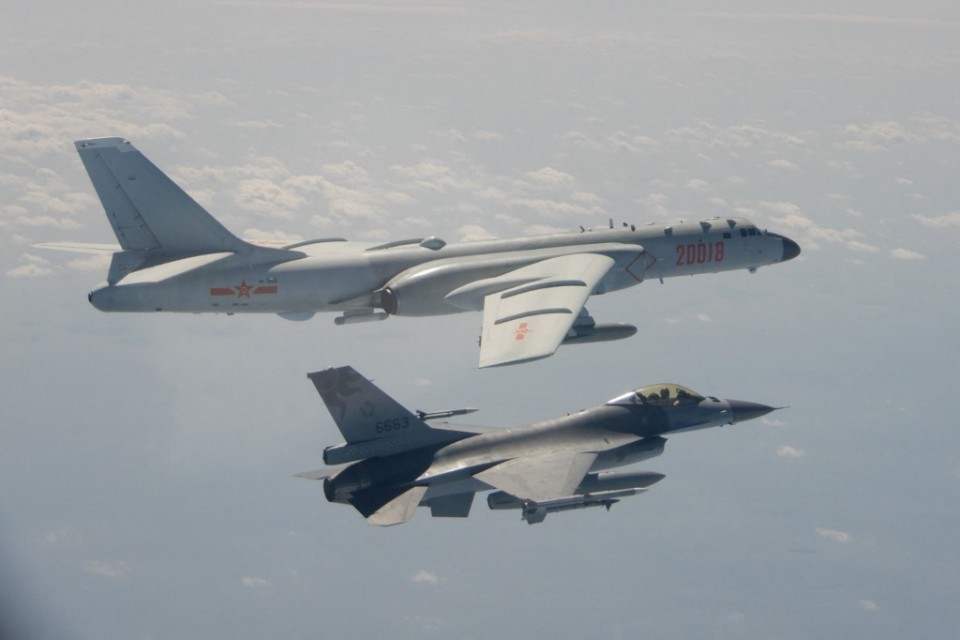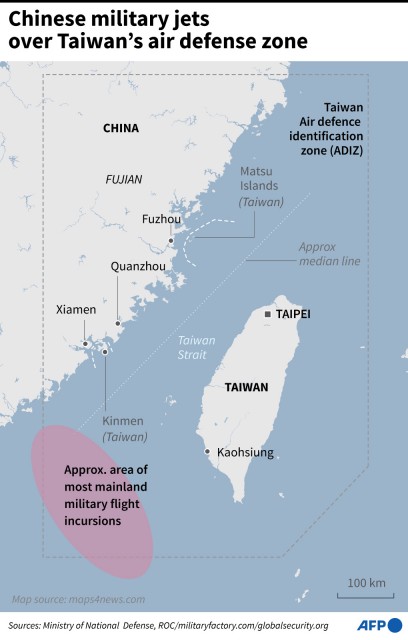

by Amber Wang and Jerome Taylor in Hong Kong
Agence France Presse
TAIPEI, Taiwan (AFP) — Chinese fighter jets crowding Taiwan’s radar screens are Beijing’s latest tool to ramp up pressure on the democratic island, sparking fears that one mistake could suddenly turn a festering cold conflict into an all-out war.
Self-ruled Taiwan has lived under the threat of a Chinese invasion since the two sides split at the end of a civil war in 1949.
Its 23 million people have since learned to cope with periods of sabre-rattling from Beijing.
But the sudden spike in Chinese war planes crossing into the island’s air defence identification zone (ADIZ) has focused attention on Taiwan, fuelling concerns it could become a global flashpoint.
AFP has compiled a database that documents all the known incursions since Taiwan’s defence ministry began making them public in September 2020, showing how sorties have crescendoed in frequency and size.
The most dramatic incursion occurred at the start of this month as China marked its annual national day when a record 149 flights crossed into Taiwan’s southwestern air defence zone in four days.
Adding aggressiveness to the incursions, some of them even got personal.
In one radio broadcast posted online by aviation fans, a Chinese pilot could be heard insulting the mother of a Taiwanese combat air traffic controller.
– ‘Psychological pressure’ –
Those four days alone saw a 28 percent increase on the total for September which was, until then, the month with the highest number of flights at 117.


Last year, Taiwan said it recorded some 380 incursions into its southwestern air defence zone. So far this year the total is already double that at 692, as of October 22.
There has also been a steady increase in sorties using the kind of planes that would be used to strike Taiwan were an invasion to take place, including the nuclear-capable H6 bomber.
In September 2020, the month that year with the highest number of sorties, Taiwan recorded incursions by 32 fighters and three bombers.
So far this month, there have been 124 fighter jet incursions and 16 by bombers.
Still, analysts say the threat posed by these incursions should not be exaggerated.
The ADIZ is not the same as Taiwan’s territorial airspace.
Instead it includes a larger area that overlaps with part of China’s own air defence identification zone — and even covers some of the mainland.
Nonetheless, it bears noting that until last year China very rarely crossed into the southwestern sector at all.
“These are part of what we call ‘greyzone’ tactics, it keeps psychological pressure on Taiwan,” Lee Hsi-min, a retired admiral who stepped down as head of Taiwan’s armed forces in 2019, told AFP.
Greyzone is a term used by military analysts to describe aggressive actions by a state that stop short of open warfare — what British defence secretary Ben Wallace has described as “the limbo land between peace and war”.
Taiwan has seen a surge in these kinds of threats since the 2016 election of President Tsai Ing-wen, whom China’s leaders loathe because she views the island as sovereign and not part of Beijing’s “one China”.
Lee cited greyzone measures such as ramped up cyber-attacks and disinformation campaigns to a massive increase in Chinese dredgers taking sand from waters surrounding Kinmen and Matsu, two Taiwanese islands just a few kilometres from the mainland.
The ADIZ incursions, he added, allowed China to “improve pilot training”, including the occasional night-time sorties, as well as test Taiwan’s own defences.
They also keep Taiwan’s already ageing fleet of fighters under stress. There have been multiple fatal crashes blamed on mechanical failures.
– ‘Perfect storm’ –
China, which has vowed to one day seize Taiwan, says little about its ADIZ incursions.
But analysts say they send a message to three targets: Taiwan’s government and people, China’s increasingly nationalist domestic audience, and western powers.
This month’s record incursions came after naval exercises in the Pacific attended by multiple navies, including two US and one British aircraft carriers and a Japanese helicopter destroyer.
It also came after Washington’s recent deal to share nuclear submarine technology with Australia and confirmation that US special forces were training Taiwanese troops.
“Beijing wants to demonstrate that it will not be intimidated by regional security alliances in the making, which undoubtedly are aimed at China,” J Michael Cole, an expert with the Washington-based Global Taiwan Institute.
“(It) also demonstrates to a domestic audience that it is not complacent about developments that favour Taiwan,” he told AFP.
The United States has long maintained a policy of “strategic ambiguity” towards Taiwan, selling it arms without explicitly promising to come to the island’s help.
But President Joe Biden has now twice stated that US forces would defend Taiwan’s people if China made a move on them.
While the ADIZ incursions remain far out to sea, many fear the rise in sorties increases the risk of a crash, collision or mistake that could spark a wider war.
President Xi Jinping, China’s most authoritarian leader since Mao Zedong, has made seizing Taiwan a key pledge as he engineers a third term push next year.
China’s increased forcefulness has prompted US and Taiwanese officials to publicly warn that Beijing could be ready to invade in just a few years.
Jia Qingguo, an international relations expert at Peking University who advises the Chinese government, published a stark paper earlier this summer in which he warned a “perfect storm” was brewing in the Taiwan Strait.
Beijing’s more aggressive treatment of Taiwan in recent years was “shaped by its growing military capabilities and increasing domestic demands for unification,” he argued.
China also feels pressured to act now against the growing relationship between Taiwan and the United States, where defending Taipei has become a rare bipartisan issue.
“The three sides have seen their interactions caught in a vicious spiral, making a military confrontation and even an all-out war an increasingly likely scenario,” Jia warned.
Su Tzu-yun, a military expert at Taiwan’s Institute for National Defense and Security Research, said Taipei “should be more vigilant but it needn’t be over-worried”.
An amphibious landing across the Taiwan Strait, he told AFP, still remains “the most complex military operation and if any part of the process is undermined, the operation would fail”.
“(China) could start a war but whether it could win it is a different thing,” he added.
© Agence France-Presse
